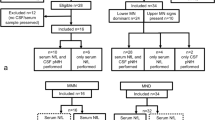Abstract
The diagnosis of peripheral neuropathies can be challenging with consequent difficulties in patients’ management. The aim of this study was to explore the current diagnostic role of sural nerve biopsy and to compare pathological findings with serum neurofilament light chain levels (NfL) as biomarkers of axonal damage. We collected demographic, clinical, and paraclinical data of patients referred over 1 year to the Neurology Unit, University of Verona, Italy, to perform nerve biopsy for diagnostic purposes, and we analyzed NfL levels in available paired sera using a high sensitive technique (Quanterix, Simoa). Eighty-two patients were identified (37.8% females, median age 65.5 years). Neuropathy onset was frequently insidious (68.3%) with a slowly progressive course (76.8%). Lower limbs were usually involved (81.7%), with a predominance of sensory over motor symptoms (74.4% vs 42.7%). The most common neuropathological findings were a demyelinating pattern (76.8%), clusters of regenerations (58.5%), and unmyelinated fibers involvement on ultrastructural evaluation (52.4%). A definite pathological diagnosis was achieved in 29 cases, and in 20.7% of patients, the referral clinical diagnosis was modified. Coexistent hematological conditions and hepatitis were diagnostic confounding factors (p = 0.012 and 0.034, respectively). In the analyzed paired sera (n = 37), an inverse despite not significant relationship between NfL values and fiber density was observed (Spearman’s rho − 0.312, p = 0.056). In addition, we noted increased serum NfL values of patients with active axonal degeneration. Nerve biopsy remains a useful diagnostic investigation to achieve a correct diagnosis and guide patients’ management in selected cases of peripheral neuropathy. Serum NfL is an accessible and potential valuable marker of axonal damage in these conditions.


Similar content being viewed by others
Availability of data and material
The corresponding author takes full responsibility for the data, the analyses and interpretation, and the conduct of the research.
References
McLeod JG (2000) Sural nerve biopsy. J Neurol Neurosurg Psychiatry 69:431
Chambers AR, Song K (2020) Sural nerve biopsy. In: StatPearls Treasure Island (FL): StatPearls Publishing
Briani C, Visentin A, Campagnolo M et al (2019) Peripheral nervous system involvement in lymphomas. J Peripher Nerv Syst 24:5–18
Gasparotti R, Lucchetta M, Cacciavillani M et al (2015) Neuroimaging in diagnosis of atypical polyradiculoneuropathies: report of three cases and review of the literature. J Neurol 262:1714–1723
Dyck PJ, Lofgren EP (1966) Method of fascicular biopsy of human peripheral nerve for electrophysiologic and histologic study. Mayo Clin Proc 41:778–784
Pant I, Jha K, Singh R, Kushwaha S, Chaturvedi S (2018) Peripheral neuropathy and the role of nerve biopsy: a revisit. Indian J Pathol Microbiol 61:339–344
Sommer CL, Brandner S, Dyck PJ et al (2010) Peripheral Nerve Society. Peripheral Nerve Society Guideline on processing and evaluation of nerve biopsies. J Peripher Nerv Syst 15:164–175
Mariotto S, Farinazzo A, Magliozzi R, Alberti D, Monaco S, Ferrari S (2018) Serum and cerebrospinal neurofilament light chain levels in patients with acquired peripheral neuropathies. J Peripher Nerv Syst 23:174–177
van Lieverloo GGA, Wieske L, Verhamme C et al (2019) Serum neurofilament light chain in chronic inflammatory demyelinating polyneuropathy. J Peripher Nerv Syst 24:187–194
Monaco S, Bonetti B, Ferrari S et al (1990) Complement-mediated demyelination in patients with IgM monoclonal gammopathy and polyneuropathy. N Engl J Med 322:649–652
Mariotto S, Gajofatto A, Zuliani L et al (2019) Serum and CSF neurofilament light chain levels in antibody-mediated encephalitis. J Neurol 266:1643–1648
Mariotto S, Ferrari S, Monaco S (2014) HCV-related central and peripheral nervous system demyelinating disorders. Inflamm Allergy Drug Targets 13:299–304
Smith EML, Kuisell C, Kanzawa-Lee GA, Toxic Neuropathy Consortium of the Peripheral Nerve Society et al (2020) Approaches to measure paediatric chemotherapy-induced peripheral neurotoxicity: a systematic review. Lancet Haematol 7:e408–e417
Mariotto S, Ferrari S, Sorio M et al (2015) Brentuximab vedotin: axonal microtubule's Apollyon. Blood Cancer J 5:e343
Sandelius A, Zetterberg H, Blennow K et al (2018) Plasma neurofilament light chain concentration in the inherited peripheral neuropathies. Neurology 90:e518–e524
Altmann P, De Simoni D, Kaider A et al (2020) Increased serum neurofilament light chain concentration indicates poor outcome in Guillain–Barré syndrome. J Neuroinflamm 17:86
Kapoor M, Foiani M, Hesleggrave A (2019) Plasma neurofilament light chain concentration is increased and correlates with the severity of neuropathy in hereditary transthyretin amyloidosis. J Peripher Nerv Syst 24:314–319
Tiedt S, Duering M, Barro C et al (2018) Serum neurofilament light: a biomarker of neuroaxonal injury after ischemic stroke. Neurology 91:e1338–e1347
Acknowledgements
We would like to thank the Centro Piattaforme tecnologiche, University of Verona for providing the Quanterix, Simoa to measure NfL levels.
Funding
Not applicable.
Author information
Authors and Affiliations
Corresponding author
Ethics declarations
Conflicts of interest
Sa.Ma. received support for attending scientific meetings by Merck and Euroimmun and received speaker honoraria from Biogen. SF received support for attending scientific meetings by Shire, Sanofi Genzyme, and Euroimmun. The other authors declare that they have no conflict of interest.
Ethics standards
All human studies have been performed in accordance with the ethical standards laid down in the 1964 Declaration of Helsinki and its later amendments.
Consent to participate
We collected consented to diagnostic procedures and biological sample storage at the referring laboratory for research use from all patients or legal representatives.
Code availability
Not applicable.
Rights and permissions
About this article
Cite this article
Mariotto, S., Carta, S., Bozzetti, S. et al. Sural nerve biopsy: current role and comparison with serum neurofilament light chain levels. J Neurol 267, 2881–2887 (2020). https://doi.org/10.1007/s00415-020-09949-3
Received:
Revised:
Accepted:
Published:
Issue Date:
DOI: https://doi.org/10.1007/s00415-020-09949-3




